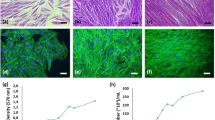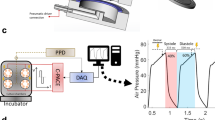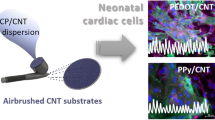Abstract
Background:
Various cell-culture systems have been used to evaluate drug toxicity in vitro. However, factors that affect cytotoxicity outcomes in drug toxicity evaluation systems remain elusive. In this study, we used multilayered sheets of cardiac-mimetic cells, which were reprogrammed from human fibroblasts, to investigate the effects of the layer number on drug cytotoxicity outcomes.
Methods:
Cell sheets of cardiac-mimetic cells were fabricated by reprogramming of human fibroblasts into cardiac-mimetic cells via coculture with cardiac cells and electric stimulation, as previously described. Double-layered cell sheets were prepared by stacking the cell sheets. The mono- and double-layered cell sheets were treated with 5-fluorouracil (5-FU), an anticancer drug, in vitro. Subsequently, apoptosis and lipid peroxidation were analyzed. Furthermore, effects of cardiac-mimetic cell density on cytotoxicity outcomes were evaluated by culturing cells in monolayer at various cell densities.
Results:
The double-layered cell sheets exhibited lower cytotoxicity in terms of apoptosis and lipid peroxidation than the mono-layered sheets at the same 5-FU dose. In addition, the double-layered cell sheets showed better preservation of mitochondrial function and plasma membrane integrity than the monolayer sheets. The lower cytotoxicity outcomes in the double-layered cell sheets may be due to the higher intercellular interactions, as the cytotoxicity of 5-FU decreased with cell density in monolayer cultures of cardiac-mimetic cells.
Conclusion:
The layer number of cardiac-mimetic cell sheets affects drug cytotoxicity outcomes in drug toxicity tests. The in vitro cellular configuration that more closely mimics the in vivo configuration in the evaluation systems seems to exhibit lower cytotoxicity in response to drug.





Similar content being viewed by others
References
Gintant G, Burridge P, Gepstein L, Harding S, Herron T, Hong C, et al. Use of human induced pluripotent stem cell-derived cardiomyocytes in preclinical cancer drug cardiotoxicity testing: a scientific statement from the american heart association. Circ Res. 2019;125:e75–92.
Murphy SL, Kochanek KD, Xu J, Heron M. Deaths: final data for 2012. Natl Vital Stat Rep. 2015;63:1–117.
Sacchetto C, Vitiello L, de Windt LJ, Rampazzo A, Calore M. Modeling cardiovascular diseases with hiPSC—derived cardiomyocytes in 2D and 3D Cultures. Int J Mol Sci. 2020;21:3404.
Del Álamo JC, Lemons D, Serrano R, Savchenko A, Cerignoli F, Bodmer R, et al. High throughput physiological screening of iPSC—derived cardiomyocytes for drug development. Biochim Biophys Acta. 2016;1863:1717–27.
Sachinidis A. Cardiotoxicity and heart failure: Lessons from human-induced pluripotent stem cell-derived cardiomyocytes and anticancer drugs. Cells. 2020;9:1001.
Laverty H, Benson C, Cartwright E, Cross M, Garland C, Hammond T, et al. How can we improve our understanding of cardiovascular safety liabilities to develop safer medicines? Br J Pharmacol. 2011;163:675–93.
Bravery CA. Do human leukocyte antigen-typed cellular therapeutics based on induced pluripotent stem cells make commercial sense? Stem Cells Dev. 2015;24:1–10.
Jacquet L, Stephenson E, Collins R, Patel H, Trussler J, Al-Bedaery R, et al. Strategy for the creation of clinical grade hESC line banks that HLA-match a target population. EMBO Mol Med. 2013;5:10–7.
Song SY, Yoo J, Go S, Hong J, Sohn HS, Lee JR, et al. Cardiac-mimetic cell-culture system for direct cardiac reprogramming. Theranostics. 2019;9:6734–44.
Song SY, Kim H, Yoo J, Kwon SP, Park BW, Kim JJ, et al. Prevascularized, multiple-layered cell sheets of direct cardiac reprogrammed cells for cardiac repair. Biomater Sci. 2020;8:4508–20.
Antoni D, Burckel H, Josset E, Noel G. Three-dimensional cell culture: a breakthrough in vivo. Int J Mol Sci. 2015;16:5517–27.
Horvath P, Aulner N, Bickle M, Davies AM, Nery ED, Ebner D, et al. Screening out irrelevant cell-based models of disease. Nat Rev Drug Discov. 2016;15:751–69.
Kim HJ, Sung IY, Cho YC, Kang MS, Rho GJ, Byun JH, et al. Three-dimensional spheroid formation of cryopreserved human dental follicle-derived stem cells enhances pluripotency and osteogenic induction properties. Tissue Eng Regen Med. 2019;16:513–23.
Md Nazir N, Zulkifly AH, Khalid KA, Zainol I, Zamli Z, Sha’ban M. Matrix production in chondrocytes transfected with sex determining region Y-Box 9 and telomerase reverse transcriptase genes: an in vitro evaluation from monolayer culture to three-dimensional culture. Tissue Eng Regen Med. 2019;16:285–99.
Ryu S, Yoo J, Han J, Kang S, Jang Y, Han HJ, et al. A cellular layer-by-layer coculture platform using biodegradable, nanoarchitectured membranes for stem cell therapy. Chem Mater. 2017;29:5134–47.
Ryu S, Yoo J, Jang Y, Han J, Yu SJ, Park J, et al. Nanothin coculture membranes with tunable pore architecture and thermoresponsive functionality for transfer-printable stem cell-derived cardiac sheets. ACS Nano. 2015;9:10186–202.
Deveci HA, Nazıroğlu M, Nur G. 5-Fluorouracil-induced mitochondrial oxidative cytotoxicity and apoptosis are increased in MCF-7 human breast cancer cells by TRPV1 channel activation but not Hypericum perforatum treatment. Mol Cell Biochem. 2018;439:189–98.
Koçer M, Nazıroğlu M. Effects of 5-fluorouracil on oxidative stress and calcium levels in the blood of patients with newly diagnosed colorectal cancer. Biol Trace Elem Res. 2013;155:327–32.
Santandreu FM, Valle A, Oliver J, Roca P. Resveratrol potentiates the cytotoxic oxidative stress induced by chemotherapy in human colon cancer cells. Cell Physiol Biochem. 2011;28:219–28.
Sara JD, Kaur J, Khodadadi R, Rehman M, Lobo R, Chakrabarti S, et al. 5-fluorouracil and cardiotoxicity: a review. Ther Adv Med Oncol. 2018;10:1758835918780140.
Zhang D, Ma J. Mitochondrial dynamics in rat heart induced by 5-fluorouracil. Med Sci Monit. 2018;24:6666–72.
Archer CR, Sargeant R, Basak J, Pilling J, Barnes JR, Pointon A. Characterization and validation of a human 3D cardiac microtissue for the assessment of changes in cardiac pathology. Sci Rep. 2018;8:10160.
Acknowledgements
This work was supported by the National Research Foundation of Korea funded by the Ministry of Science (2017R1A2B3005842).
Author information
Authors and Affiliations
Corresponding author
Ethics declarations
Conflicts of interest
The authors declare no conflicts of interest.
Ethical statement
There are no animal experiments carried out for this article.
Additional information
Publisher's Note
Springer Nature remains neutral with regard to jurisdictional claims in published maps and institutional affiliations.
Supplementary Information
Below is the link to the electronic supplementary material.
Rights and permissions
About this article
Cite this article
Kwon, S.P., Song, S.Y., Yoo, J. et al. Multilayered Cell Sheets of Cardiac Reprogrammed Cells for the Evaluation of Drug Cytotoxicity. Tissue Eng Regen Med 18, 807–818 (2021). https://doi.org/10.1007/s13770-021-00363-y
Received:
Revised:
Accepted:
Published:
Issue Date:
DOI: https://doi.org/10.1007/s13770-021-00363-y




